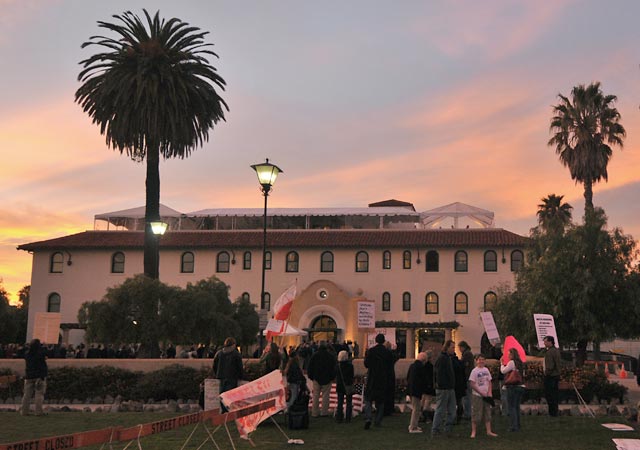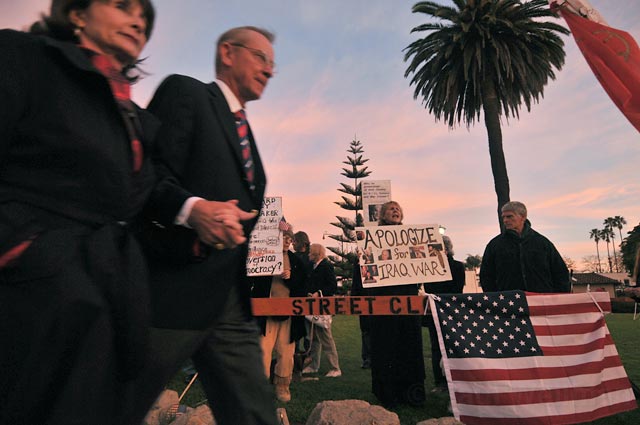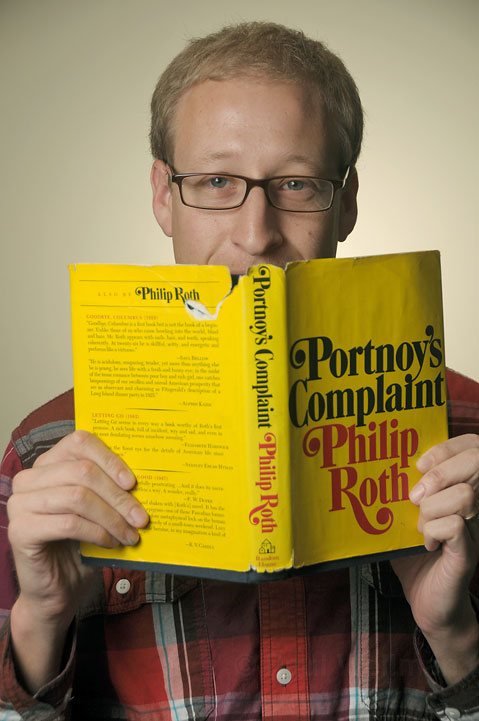Stuck Between a Poodle and a Pitbull
Palin the New Reagan?

Although the Santa Barbara International Film Festival was still running this past weekend, the biggest celebrity in town was not a movie star. Sarah Palin, the former vice-presidential candidate and half-term governor of Alaska, and current media personality, spent Friday riding horses at the Ronald Reagan Ranch before giving the keynote address at the Young America’s Foundation (YAF) celebration of Reagan’s centennial birthday.
In a somewhat contradictory speech, Palin lauded the wide open spaces of the Central Coast but criticized the state’s environmental protections, insinuated that the Obama administration is socialist and then referred to it as an example of “crony capitalism,” decried big business but advocated for big oil. She reliably delivered predicates before subjects and served up pot shots in the form of puns (the left’s idea of American exceptionalism is “exceptionally large government”) along with some mind-bendingly mixed metaphors. (“There is a whole army of patriotic Davids out there across this country. These Davids aren’t afraid to tell Goliath, ‘Don’t tread on me.’”)

For better or for worse, Sarah Palin plays a critical role in the national zeitgeist and I was excited to pass through the orbit of her celebrity. When I called up to get my press pass, however, YAF program officer Evan Gassman refused to take my call. Shortly thereafter, he sent me an email saying, “Due to overwhelming demand, we are unfortunately unable to offer you press credentials for our banquet with Gov. Palin. Please feel free to watch the events live on UStream.tv. We’re sorry for any inconvenience this may have caused.”
This response from a young man who cut his teeth interning for conservative radio host Laura Ingraham may or may not have anything to do with the Angry Poodle Barbecue column, published in this paper the day before, that referred to Palin as “a sassy, brassy, loud-mouthed MILF with no record of actual accomplishment.” I can only speculate, but a colleague who attended the event told me there was more than enough room for one more reporter, especially one as svelte as myself.
Despite Gassman’s concerns, it was not a terrible inconvenience. As good as the food served at the banquet must have been it couldn’t have beaten the take-out Santa Barbara Chicken Ranch burrito I munched on while watching Palin on C-SPAN. Before her speech, though, I did head on over to the Reagan Ranch Center to check out the scene.
Bob Dorn, who runs a consulting firm and worked on Reagan’s 1984 presidential campaign, prowled around the perimeter like a panther, stopping to preen and chat up a group of ticketless Palin supporters, showing off his 24-carat-gold elephant pin. He told me that maybe I would have gotten into the talk if I’d worn a suit. I told him I would have happily donned a suit if I had been offered a press pass.

Waving toward a group of dreadlocked bongo-beating protesters, Dorn, who is also the former chair of the Santa Barbara County Economic Development Commission, said that “Santa Barbara wasn’t built on t-shirts and peace signs.” He showed the protective instincts of an old campaign hand hardened by the trench warfare of electoral politics. In a world organized by friends and enemies, I was an enemy by dint of the publication I was writing for.
Oddly, the activists—both left and right—saw the possibility of common ground where the pros didn’t. “My neighbors here,” said Palinphile Marlene Minnis, referring to the protestors, “are saying they hate bombs and war. We do too.”
Artist and activist Nancy Tunnell, a lonely boomer among a small handful of college-aged protestors, said, “Both [political parties] are controlled. If you choose a side, you will be controlled.”
When I asked Minnis and her girlfriends why Palin was attractive to them, two of their male companions started laughing. Clearly what made her attractive to them was her attractiveness.
Sarah Palin certainly commands attention—whether it be for her hardbodied dominatrix-inspired aesthetic or her unabashed willingness to make provocative declarations (see panels, death). She’s certainly a hot ticket. Plenty of people paid to see her speak in Santa Barbara. (I called and emailed to inquire about ticket prices and attendance numbers but did not receive a response.) The question I had was whether she was the perfect embodiment of Ronald Reagan’s legacy.
On the surface, the two political figures have a lot in common. They both entered politics after careers performing in front of cameras, Reagan as an actor and Palin as a sportscaster. After entering politics they both cultivated an anti-intellectual ethos which they compounded with their palpable lack of intellectual activity. In one of his Reagan biographies, Lou Cannon says that when Reagan was starting out he was “almost completely ignorant of even civics-book information about how bills were passed or how an administration functioned.” In their salacious tell-all account of the 2008 presidential elections, Mark Halperin and John Heilmann write that Steve Schmidt, John McCain’s campaign manager, told the two foreign policy experts hired to give Sarah Palin a crash course in history and politics, “You guys have a lot of work to do. She doesn’t know anything.”
Despite the early stumbling block of ignorance, Reagan managed to turn himself into a highly successful politician with an articulated value system and a distinct governing style. Palin has managed to get herself rich, but her star as a government official is on the descent. Not only did she quit halfway through her term as Alaska’s governor but a CNN/Opinion Research poll released on January 19 showed her unfavorable rating had risen to 56 percent. The sort of fame necessary to sell thousands of books or garner millions of television viewers pales in comparison to the popularity necessary to win over the majority of voters in a national contest.
In her introductory remarks YAF Vice President Kate Obenshain compared Palin’s emergence on the political scene to Reagan’s after his 1964 “A Time For Choosing” speech made conservative hearts go pitter-pat. Barry Goldwater, whom Reagan was endorsing, lost the election as did Palin in 2008, and Obenshain suggested that Reagan and Palin were ahead of the curve. They both lost early battles but ushered in Republican revolutions. This is certainly true of Reagan, but still to be seen with Palin.
Palin’s speech on Friday night offered her the chance to define herself as a political figure; to explain how Ronald Reagan influenced her own politics or how she might revise Reaganism for the 21st century. She started off on a promising note, telling her audience that, like Reagan, she was a “Western conservative” who drew her values from the “pioneering spirit.” It was a theme to build upon, but she soon drifted off into condemning the intellectual elite in D.C., decrying the national debt, criticizing Democratic policies, and praising the military. That is all boilerplate fare for a conservative political speech, but in the end there was no overarching message or unifying theme, nothing to sink your teeth into.
I left—or rather, turned off my television—feeling that if Sarah Palin had a message for young Americans, it was merely the same one they receive from apolitical media: Success can be measured in Facebook fans, image trumps ethics, a good brand beats a good idea. In fact, news broke earlier that same day that Palin and daughter Bristol had filed applications to trademark their names.



